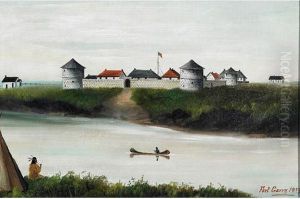Lawrence Macdonald Paintings
Lawrence Macdonald was a prominent Scottish sculptor known for his neoclassical style, born in 1799 in Gask, Perthshire, Scotland. Although not as widely recognized as some of his contemporaries, Macdonald made significant contributions to the world of art, particularly in the realm of sculpture during the 19th century.
Macdonald began his career as a stonemason, which laid the foundation for his sculptural skills. His talent was evident early on, and he was encouraged to pursue further training. He moved to Edinburgh to become an apprentice under the sculptor James Gillespie Graham. During this period, Macdonald honed his craft, and his dedication to sculpture became increasingly apparent.
In 1822, he left Scotland for Rome, which was then the centre of the neoclassical art world. The move to Rome was pivotal; it was there that Macdonald studied under the esteemed Danish sculptor Bertel Thorvaldsen, who was a major proponent of the neoclassical style that sought to revive the artistic principles of ancient Greece and Rome. Under Thorvaldsen's guidance, Macdonald developed his own style and began to attract a clientele that included wealthy patrons and members of the British aristocracy.
Throughout his career, Macdonald exhibited a mastery of form and a deep understanding of classical beauty. His works, often carved from marble, include busts, statues, and reliefs. He became known for his ability to capture not just the physical likeness but also the character and spirit of his subjects. Some of his notable works include a statue of Sir Walter Scott for the Scott Monument in Edinburgh and the marble bust of the Roman goddess Flora, which is considered one of his masterpieces.
Macdonald spent the majority of his life in Italy, where he continued to work and teach. He became an influential figure in the British expatriate community in Rome and was known for his generous support of young artists. Despite his success, he maintained strong ties to Scotland, returning there on several occasions.
Lawrence Macdonald died in 1878, leaving behind a legacy of work that remains appreciated for its technical skill and adherence to neoclassical ideals. His sculptures can be found in various collections, including the National Galleries of Scotland, where they continue to be admired for their elegance and craftsmanship.
